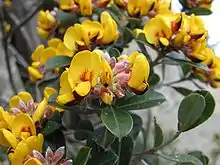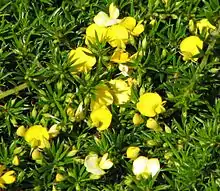Pultenaea
Pultenaea is a genus of flowering plants in the family Fabaceae-Faboideae that are native to Australia. They are known commonly as bush peas.
| Pultenaea | |
|---|---|
 | |
| Pultenaea daphnoides | |
| Scientific classification | |
| Kingdom: | |
| (unranked): | |
| (unranked): | |
| (unranked): | |
| Order: | |
| Family: | |
| Subfamily: | |
| (unranked): | |
| Genus: | Pultenaea |
| Type species | |
| Pultenaea stipularis | |
| Species | |
 | |
| Range of Pultenaea Sm. | |
.jpg.webp)
The genus is found in south west Western Australia and the eastern states. It is not considered to be monophyletic[1] with suggestions of splitting it into six separate subgenera, under a larger genus of Pultenaea sensu lato, which would include 19 out of 25 genera included in the former tribe Mirbelieae.[2] The genus underwent explosive starburst radiation, with biogeographical divisions due to the Nullarbor Plain and the winter/summer rainfall boundary. Some species rely on fire regimes for germination, and are an understorey dominant and nitrogen fixer.
Taxonomy and Phylogeny
The genus was first formally described by botanist James Edward Smith in 1794 in A Specimen of the Botany of New Holland, with Pultenaea stipularis nominated as the type species.[3] The latter was described from a living specimen which was raised in Stockwell, England from seed obtained from New South Wales in 1792.[4] Smith named the genus in honour of Richard Pulteney, an English surgeon and botanist, who also was the biographer of Linnaeus.[5]
Phylogeny
Pultenaea belongs to the Mirbelioid clade of the legume subfamily Faboideae. Pultenaea is paraphyletic with respect to several of the other mirbelioid genera.[6][7] Molecular phylogenetics supports 7 clades within the current circumscription of Pultenaea:
- Western Australia
- Pultenaea quaerita clade
- Pultenaea ericifolia–Pultenaea indira clade
- Pultenaea skinner–Pultenaea reticulata clade
- Pultenaea brachytropis (monotypic)
- Eastern Australia
- subgenus Chaodes
- subgenus Pultenaea
- subgenus Corrickosa
Speciation
The Mirbelioids have had long isolation in Australia from other Fabaceae families. Pultenaea Sm. underwent explosive starburst radiation during the late Miocene, due to aridity.[2] Geographic speciation factors include east vs. west endemism due to increased aridity and the development of the Nullarbor Plain; subgenera Pultenaea and Corrickosa of eastern Australia split along the Winter–Summer rainfall boundary; subclades within Corrickosa diverged due to marine incursions between South Australia and Victoria. Western Australian species include disjunctions between north and south, and Esperance/Cape Arid. Recent extinctions, possibly due to changed fire regimes and grazing pressure, include P. elusa and P. maidenii.[8]
Species
Species include:
- Pultenaea daphnoides Wendl.—Large-leaf bush-pea
- Pultenaea densifolia F.Muell.—Dense-leaf bush-pea
- Pultenaea flexilis Sm.—Graceful bush-pea
- Pultenaea gunnii Benth.—Golden bush-pea
- Pultenaea juniperina Labill.—Prickly bush-pea
- Pultenaea muelleri Benth.—Mueller's bush-pea
- Pultenaea pauciflora M.B. Scott—Narrogin pea
- Pultenaea pedunculata Hook.—Matted bush-pea
- Pultenaea rosmarinifolia Lindl.—Rosemary-leaved pultenaea, Rosemary bush-pea[9]
- Pultenaea scabra R.Br.—Rough bush-pea
- Pultenaea tenuifolia R.Br. ex Sims—Slender bush-pea
Distribution and habitat

Pultenaea Sm. are restricted to south west Western Australia and temperate and tropical regions of the eastern states of Australia. They are found in sclerophyllous vegetation types varying from forests to heath lands, but absent from arid interior and rainforest regions. Its distribution indicates that the genus is limited by water (arid regions) and sunlight/competition (tropical regions). Eastern Australia contains 87 species,while Western Australia contains 27 species. Four species are found in both regions.
Ecology
Pultenaea species are understorey dominants, play a role of nutrient cycling as nitrogen fixers, and are an important food source for invertebrates. Like many species of Fabaceae, hard-seeded Pultenaea species require fire for germination and recruitment e.g. P. williamsoniana. A periodic fire regime of at least ten years is needed to allow for maturity. Pultenaea species can be locally abundant, and are abundant along roadsides, possibly due to increased light or disturbance. Threats include clearance and fragmentation of habitat, inappropriate fire regimes, weed invasion, and grazing, which may have led to extinctions of P. elusa and P. maidenii
Cultivation
A number of species are cultivated for their spring flower display. Most of these are fast-growing and adaptable to diverse growing conditions. Propagation is from semi-mature cuttings or seed pre-treated by soaking in hot water.[10]
Three cultivars are registered with the Australian Cultivar Registration Authority:
- Pultenaea pedunculata 'Pyalong Gold'
- Pultenaea pedunculata 'Pyalong Pink'
- Pultenaea villosa 'Wallum Gold'—a prostrate form[11]
References
- Orthia LA, Cook LG, Crisp MD. (2005). "Generic delimitation and phylogenetic uncertainty: An example from a group that has undergone an explosive radiation". Aust Syst Bot. 18 (1): 41–47. doi:10.1071/SB04016.CS1 maint: multiple names: authors list (link)
- Orthia LA, Cook LG, Crisp MD, deKok RPJ. (2005). "Bush peas: A rapid radiation with no support for monophyly of Pultenaea (Fabaceae: Mirbelieae)". Aust Syst Bot. 18 (2): 133–147. doi:10.1071/SB04028.CS1 maint: multiple names: authors list (link)
- "Pultenaea". Australian Plant Name Index (APNI), IBIS database. Centre for Plant Biodiversity Research, Australian Government, Canberra. Retrieved 2009-10-17.
- Smith EJ. (1793). A Specimen of the Botany of New Holland. London: James Sowerby.
- Crisp M. (2 May 2009). "Fabaceae tribe Mirbelieae: Pultenaea". The Australian National University. Archived from the original on 14 October 2009. Retrieved 15 October 2009.
- Crisp M, Cook LG. (2003). "Phylogeny and embryo sac evolution in the endemic Australasian papilionoid tribes Mirbelieae and Bossiaeeae". In Klitgaard BB, Bruneau A (ed.). Advances in Legume Systematics, Part 10: Higher Level Systematics. Royal Botanic Gardens, Kew. pp. 253–268. ISBN 9781842460542.
- Bickford SA, Laffan SW, de Kok RPJ, Orthia LA. (2004). "Spatial analysis of taxonomic and genetic patterns and their potential for understanding evolutionary histories". Journal of Biogeography. 31 (11): 1715–173. doi:10.1111/j.1365-2699.2004.01127.x.CS1 maint: multiple names: authors list (link)
- de Kok RPJ, West JG. (2004). "A revision of the genus Pultenaea (Fabaceae). 3. The eastern species with recurved leaves". Aust Syst Bot. 17 (3): 273–326. doi:10.1071/SB02028.
- "Pultenaea rosmarinifolia". Australian Plant Name Index (APNI), IBIS database. Centre for Plant Biodiversity Research, Australian Government, Canberra. Retrieved 2008-11-14.
- Greig D. (1987). The Australian Gardener's Wildflower Catalogue. Australia: Angus & Robertson. ISBN 978-0207154607.
- "List of Registered Cultivars derived from Australian native flora". Australian Cultivar Registration Authority. Retrieved 2009-10-14.
| Wikispecies has information related to Pultenaea. |
| Wikimedia Commons has media related to Pultenaea. |
